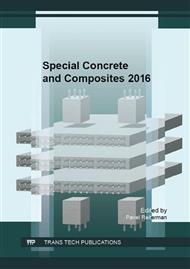[1]
F. Schladitz, M. Frenzel, D. Ehlig, M. Curbach, Bending load capacity of reinforced concrete slabs strengthened with textile reinforced concrete, Engineering Structures 40 (2012) 317-326.
DOI: 10.1016/j.engstruct.2012.02.029
Google Scholar
[2]
T. Vlach et al., Comparison of Different Methods for Determination of Modulus of Elasticity of Composites Reinforcement Produced from Roving, Advanced Materials Research 1054 (2014) 104-109.
DOI: 10.4028/www.scientific.net/amr.1054.104
Google Scholar
[3]
T. Pavlů, L. Boehme, P. Hájek, Influence of recycled aggregate quality on the mechanical properties of concrete, Komunikacie 16 (2014) 35-40.
Google Scholar
[4]
M. Šefflová, T. Pavlů, V. Hujer, Behavior of concrete containing of fine recycled aggregate, Key Engineering Materials 677 (2016) 260-265.
DOI: 10.4028/www.scientific.net/kem.677.260
Google Scholar
[5]
J. Hegger, Ch. Kulas, M. Horstmann, Realization of TRC façades with impregnated AR-glass textiles, Key Engineering Materials 466 (2011) 121-130.
DOI: 10.4028/www.scientific.net/kem.466.121
Google Scholar
[6]
O. Holčapek, P. Reiterman, P. Konvalinka, Experimental Analysis of Hydrothermal Curing Influence on Properties of Fiber-Cement Composite, Applied Mechanics and Materials 732 (2015) 55-58.
DOI: 10.4028/www.scientific.net/amm.732.55
Google Scholar
[7]
S. Goñi, A. Guerrero, M. P. Luxán, A. Macías, Activation of the fly ash pozzolanic reaction by hydrothermal conditions, Cement and Concrete Research 33 (2003) 1399-1405.
DOI: 10.1016/s0008-8846(03)00085-1
Google Scholar
[8]
M. R. Shatat, Effect of hydrothermal curing on the hydration characteristics of artificial pozzolanic cement pastes placed in closed system, Applied Clay Science 96 (2014) 110-115.
DOI: 10.1016/j.clay.2014.04.032
Google Scholar
[9]
H. Yazici, E. Deniz, B. Baradan, The effect of autoclave pressure, temperature and duration time on mechanical properties of reactive powder concrete, Construction and Building Materials 42 (2013) 53-63.
DOI: 10.1016/j.conbuildmat.2013.01.003
Google Scholar
[10]
O. Holčapek, F. Vogel, P. Konvalinka, Analysis of mechanical properties of hydrothermally cured high strength matrix for textile reinforced concrete, Acta Polytechnica 55 (2015) 313-318.
DOI: 10.14311/ap.2015.55.0313
Google Scholar
[11]
Hartig, J., Häußer-Combe, U., Schicktanz, K., Influence of bond properties on the tensile behaviour of Textile Reinforced Concrete, Cement and Concrete Composites 30, (2008) 898-906.
DOI: 10.1016/j.cemconcomp.2008.08.004
Google Scholar
[12]
P. Reiterman, M. Jogl, V. Baumelt, J. Seifrt, Development and mix design of HPC and UHPFRC, Advanced Materials Research 982 (2014) 130-135.
DOI: 10.4028/www.scientific.net/amr.982.130
Google Scholar


